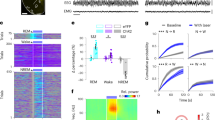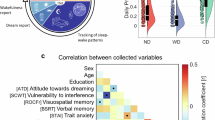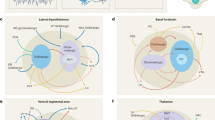Abstract
Dreaming is still poorly understood. Notably, its cerebral underpinning remains unclear. Neuropsychological studies have shown that lesions in the temporoparietal junction (TPJ) and/or the white matter of the medial prefrontal cortex (MPFC) lead to the global cessation of dream reports, suggesting that these regions of the default mode network have key roles in the dreaming process (forebrain ‘dream-on’ hypothesis). To test this hypothesis, we measured regional cerebral blood flow (rCBF) using [15O]H2O positron emission tomography in healthy subjects with high and low dream recall frequencies (DRFs) during wakefulness (rest) and sleep (rapid eye movement (REM) sleep, N2, and N3). Compared with Low recallers (0.5±0.3 dream recall per week in average), High recallers (5.2±1.4) showed higher rCBF in the TPJ during REM sleep, N3, and wakefulness, and in the MPFC during REM sleep and wakefulness. We demonstrate that the resting states of High recallers and Low recallers differ during sleep and wakefulness. It coheres with previous ERP results and confirms that a high/low DRF is associated with a specific functional organization of the brain. These results support the forebrain ‘dream-on’ hypothesis and suggest that TPJ and MPFC are not only involved in dream recall during wakefulness but also have a role in dreaming during sleep (production and/or encoding). Increased activity in the TPJ and MPFC might promote the mental imagery and/or memory encoding of dreams. Notably, increased activity in TPJ might facilitate attention orienting toward external stimuli and promote intrasleep wakefulness, facilitating the encoding of the dreams in memory.
Similar content being viewed by others
Log in or create a free account to read this content
Gain free access to this article, as well as selected content from this journal and more on nature.com
or
References
Aserinsky E, Kleitman N (1953). Regularly occurring periods of eye motility, and concomitant phenomena, during sleep. Science 118: 273–274.
Baars BJ, Ramsoy TZ, Laureys S (2003). Brain, conscious experience and the observing self. Trends Neurosci 26: 671–675.
Benoit O, Foret J (1992) Le sommeil humain: bases expérimentales physiologiques et physiopathologiques. Masson: Paris, 197pp.
Bischof M, Bassetti CL (2004). Total dream loss: a distinct neuropsychological dysfunction after bilateral PCA stroke. Ann Neurol 56: 583–586.
Blagrove M, Pace-Schott EF (2010). Trait and neurobiological correlates of individual differences in dream recall and dream content. Int Rev Neurobiol 92: 155–180.
Bortner RW (1969). A short rating scale as a potential measure of pattern A behavior. J Chronic Dis 22: 87–91.
Bouthillier D, Tremblay N, Hemalin F, Julien D, Scherzer P (1996). Traduction et validation canadienne française d'un questionnaire évaluant l'attachement chez l'adulte. Can J Behav Sci 28: 74–77.
Braun AR, Balkin TJ, Wesensten NJ, Gwadry F, Carson RE, Varga M et al (1998). Dissociated pattern of activity in visual cortices and their projections during human rapid eye movement sleep. Science 279: 91–95.
Braun AR, Balkin TJ, Wesenten NJ, Carson RE, Varga M, Baldwin P et al (1997). Regional cerebral blood flow throughout the sleep–wake cycle. An H2(15)O PET study. Brain 120 (Part 7): 1173–1197.
Brown KW, Ryan RM (2003). The benefits of being present: mindfulness and its role in psychological well-being. J Pers Soc Psychol 84: 822–848.
Coez A, Zilbovicius M, Ferrary E, Bouccara D, Mosnier I, Ambert-Dahan E et al (2009). Processing of voices in deafness rehabilitation by auditory brainstem implant. NeuroImage 47: 1792–1796.
Corbetta M, Patel G, Shulman GL (2008). The reorienting system of the human brain: from environment to theory of mind. Neuron 58: 306–324.
Cory TL, Ormiston DW (1975). Predicting the frequency of dream recall. J Abnorm Psychol 84: 261–266.
Dement W, Kleitman N (1957). The relation of eye movements during sleep to dream activity: an objective method for the study of dreaming. J Exp Psychol 53 (5): 339–346.
Dement W, Wolpert EA (1958). The relation of eye movements, body motility, and external stimuli to dream content. J Exp Psychol 55: 543–553.
Domhoff W (2011). The neural substrate for dreaming: is it a subsystem of the default network? Conscious Cogn 20: 1163–1174.
Dresler M, Koch SP, Wehrle R, Spoormaker VI, Holsboer F, Steiger A et al (2011). Dreamed movement elicits activation in the sensorimotor cortex. Curr Biol 21: 1833–1837.
Duvernoy HM (1991) The Human Brain Surface, Three-Dimensional Sectional Anatomy and MRI. Springer: New-York, NY.
Eichenlaub JB, Bertrand O, Morlet D, Ruby P (2013). Brain reactivity differentiates subjects with high and low dream recall frequencies during both sleep and wakefulness. Cereb Cortex ; e-pub ahead of print 2 January 2013 (doi:10.1093/cercor/bhs388).
Eichenlaub JB, Ruby P, Morlet D (2012). What is the specificity of the response to the own first-name when presented as a novel in a passive oddball paradigm? An ERP study. Brain Res 1447: 65–78.
Foulkes WD (1962). Dream reports from different stages of sleep. J Abnorm Soc Psychol 65: 14–25.
Friston KJ, Holmes AP, Worsley KJ, Poline JP, Frith CD, Frackowiak RSJ (1995). Statistical parametric maps in functional imaging: a general linear approach. Hum Brain Mapp 2: 189–210.
Goodenough DR, Shapiro A, Holden M, Steinschriber L (1959). A comparison of ‘dreamers’ and ‘nondreamers’: eye movements, electroencephalograms, and the recall of dreams. J Abnorm Soc Psychol 59: 295–302.
Gusnard DA, Raichle ME (2001). Searching for a baseline: functional imaging and the resting human brain. Nat Rev Neurosci 2: 685–694.
Hobson JA (2005). Sleep is of the brain, by the brain and for the brain. Nature 437: 1254–1256.
Hobson JA, Pace-Schott EF, Stickgold R (2000). Dreaming and the brain: toward a cognitive neuroscience of conscious states. Behav Brain Sci 23: 793–842.
Holeckova I, Fischer C, Giard MH, Delpuech C, Morlet D (2006). Brain responses to a subject's own name uttered by a familiar voice. Brain Res 1082: 142–152.
Holeckova I, Fischer C, Morlet D, Delpuech C, Costes N, Mauguiere F (2008). Subject's own name as a novel in a MMN design: a combined ERP and PET study. Brain Res 1189: 152–165.
Johnston DW, Shaper AG (1983). Type A behaviour in British men: reliability and intercorrelation of two measures. J Chronic Dis 36: 203–207.
Jouvet M (1962). Recherches sur les structures nerveuses et les mécanismes responsables des differentes phases du sommeil physiologique. Archives Italiennes de Biologie 100: 125–206.
Knight RT, Scabini D, Woods DL, Clayworth CC (1989). Contributions of temporal-parietal junction to the human auditory P3. Brain Res 502: 109–116.
Kosslyn SM, Ganis G, Thompson WL (2001). Neural foundations of imagery. Nat Rev Neurosci 2: 635–642.
Koulack D, Goodenough DR (1976). Dream recall and dream recall failure: an arousal–retrieval model. Psychol Bull 83: 975–984.
Lavie P (1986). Ultrashort sleep-waking schedule. III. 'Gates' and 'forbidden zones' for sleep. Electroencephalogr Clin Neurophysiol 63: 414–425.
Legrand D, Ruby P (2009). What is self-specific? Theoretical investigation and critical review of neuroimaging results. Psychol Rev 116: 252–282.
Lewis HB, Goodenough DR, Shapiro A, Sleser I (1966). Individual differences in dream recall. J Abnorm Psychol 71: 52–59.
Malaspina D, Harkavy-Friedman J, Corcoran C, Mujica-Parodi L, Printz D, Gorman JM et al (2004). Resting neural activity distinguishes subgroups of schizophrenia patients. Biol Psychiatry 56: 931–937.
Maquet P, Laureys S, Peigneux P, Fuchs S, Petiau C, Phillips C et al (2000). Experience-dependent changes in cerebral activation during human REM sleep. Nat Neurosci 3: 831–836.
Maquet P, Peters J, Aerts J, Delfiore G, Degueldre C, Luxen A et al (1996). Functional neuroanatomy of human rapid-eye-movement sleep and dreaming. Nature 383: 163–166.
Maquet P, Ruby P (2004). Psychology: insight and the sleep committee. Nature 427: 304–305.
Maquet P, Ruby P, Maudoux A, Albouy G, Sterpenich V, Dang-Vu T et al (2005). Human cognition during REM sleep and the activity profile within frontal and parietal cortices: a reappraisal of functional neuroimaging data. Prog Brain Res 150: 219–227.
Marzano C, Ferrara M, Mauro F, Moroni F, Gorgoni M, Tempesta D et al (2011). Recalling and forgetting dreams: theta and alpha oscillations during sleep predict subsequent dream recall. J Neurosci 31: 6674–6683.
Mason MF, Norton MI, Van Horn JD, Wegner DM, Grafton ST, Macrae CN (2007). Wandering minds: the default network and stimulus-independent thought. Science 315: 393–395.
Mazza S, Soucy JP, Gravel P, Michaud M, Postuma R, Massicotte-Marquez J et al (2006). Assessing whole brain perfusion changes in patients with REM sleep behavior disorder. Neurology 67: 1618–1622.
McCarley RW, Hobson JA (1975). Neuronal excitability modulation over the sleep cycle: A structural and mathematical model. Science 189: 58–60.
Murri L, Massetani R, Siciliano G, Giovanditti L, Arena R (1985). Dream recall after sleep interruption in brain-injured patients. Sleep 8: 356–362.
Nielsen TA (2000). A review of mentation in REM and NREM sleep: ‘covert’ REM sleep as a possible reconciliation of two opposing models. Behav Brain Sci 23: 851–866 discussion 904–1121.
Nir Y, Tononi G (2010). Dreaming and the brain: from phenomenology to neurophysiology. Trends Cogn Sci 14: 88–100.
Opitz B, Mecklinger A, Friederici AD, von Cramon DY (1999). The functional neuroanatomy of novelty processing: integrating ERP and fMRI results. Cereb Cortex 9: 379–391.
Peigneux P, Van der Linden M, Garraux G, Laureys S, Degueldre C, Aerts J et al (2004). Imaging a cognitive model of apraxia: the neural substrate of gesture-specific cognitive processes. Hum Brain Mapp 21: 119–142.
Pichot P, Boyer P, Pull CB, Rein W, Simon M, Thibault A (1984a). Le questionnaire QD 2. La forme abrégée QD 2A. Rev Psychol Appl 4: 323–340.
Pichot P, Boyer P, Pull CB, Rein W, Simon M, Thibault A (1984b). Un questionnaire d'auto-évaluation de la symptomatologie dépressive: le QD 2. Construction, structure factorielle, propriétés métrologiques. Rev Psychol Appl 3: 229–250.
Price CJ (2010). The anatomy of language: a review of 100 fMRI studies published in 2009. Ann N Y Acad Sci 1191: 62–88.
Raichle ME, MacLeod AM, Snyder AZ, Powers WJ, Gusnard DA, Shulman GL (2001). A default mode of brain function. Proc Natl Acad Sci USA 98 (2): 676–682.
Raichle ME, Martin WR, Herscovitch P, Mintun MA, Markham J (1983). Brain blood flow measured with intravenous H2(15)O. II. Implementation and validation. J Nucl Med 24: 790–798.
Raichle ME, Mintun MA (2006). Brain work and brain imaging. Annu Rev Neurosci 29: 449–476.
Raymond JE, Shapiro KL, Arnell KM (1992). Temporary suppression of visual processing in an RSVP task: an attentional blink? J Exp Psychol Hum Percept Perform 18 (3): 849–860.
Rechtschaffen A, Kales A (1968) A Manual of Standardized Terminology, Techniques, and Scoring Systems for Sleep Stages of Human Subjects. Brain Information/Brain Research Institute UCLA: Los Angeles, CA.
Renner B (2006). Curiosity about people: the development of a social curiosity measure in adults. J Pers Assess 87: 305–316.
Ruby P (2011). Experimental research on dreaming: state of the art and neuropsychoanalytic perspectives. Front Psychol 2: 286.
Ruby P, Blochet C, Eichenlaub JB, Bertrand O, Morlet D, Bidet-Caulet A (2013). Alpha reactivity to first names differs in subjects with high and low dream recall frequency. Front Psychol 4: 419.
Ruby P, Decety J (2001). Effect of subjective perspective taking during simulation of action: a PET investigation of agency. Nat Neurosci 4: 546–550.
Ruby P, Decety J (2003). What you believe versus what you think they believe: a neuroimaging study of conceptual perspective-taking. Eur J Neurosci 17: 2475–2480.
Ruby P, Decety J (2004). How would you feel versus how do you think she would feel? A neuroimaging study of perspective-taking with social emotions. J Cogn Neurosci 16: 988–999.
Sastre JP, Jouvet M (1979). [Oneiric behavior in cats]. Physiol Behav 22: 979–989.
Schredl M (2002). Questionnaire and diaries as research instruments in dream research: Methodological issues. Dreaming 12: 17–25.
Schredl M (2004). Reliability and stability of a dream recall frequency scale. Percept Mot Skills 98 (Part 2): 1422–1426.
Schredl M, Wittmann L, Ciric P, Gotz S (2003). Factors of home dream recall: a structural equation model. J Sleep Res 12: 133–141.
Shulman GL, Pope DL, Astafiev SV, McAvoy MP, Snyder AZ, Corbetta M (2010). Right hemisphere dominance during spatial selective attention and target detection occurs outside the dorsal frontoparietal network. J Neurosci 30: 3640–3651.
Silber MH, Ancoli-Israel S, Bonnet MH, Chokroverty S, Grigg-Damberger MM, Hirshkowitz M et al (2007). The visual scoring of sleep in adults. J Clin Sleep Med 3: 121–131.
Silva S, Alacoque X, Fourcade O, Samii K, Marque P, Woods R et al (2010). Wakefulness and loss of awareness: brain and brainstem interaction in the vegetative state. Neurology 74: 313–320.
Simpson JA (1990). Influence of attachment styles on romantic relationships. J Person Soc Psychol 59: 971–980.
Solms M (1997) The Neuropsychology of Dreams: A Clinico-Anatomical Study. Lawrence Erlbaum Associates.
Solms M (2000). Dreaming and REM sleep are controlled by different brain mechanisms. Behav Brain Sci 23: 843–850.
Tochon-Danguy HJ, Clark JC, Janus A, Sachinidis JI (1995). Technical performance and operating procedure of a bedside [15O] water infuser. J Labelled Compd Radiopharm 37: 662–666.
Vgontzas AN, Pejovic S, Zoumakis E, Lin HM, Bixler EO, Basta M et al (2007). Daytime napping after a night of sleep loss decreases sleepiness, improves performance, and causes beneficial changes in cortisol and interleukin-6 secretion. Am J Physiol Endocrinol Metab 292: E253–E261.
Wagner AD, Shannon BJ, Kahn I, Buckner RL (2005). Parietal lobe contributions to episodic memory retrieval. Trends Cogn Sci 9: 445–453.
Wamsley EJ, Tucker M, Payne JD, Benavides JA, Stickgold R (2010). Dreaming of a learning task is associated with enhanced sleep-dependent memory consolidation. Curr Biol 20: 850–855.
Witkin HA (1950). Individual differences in ease of perception of embedded figures. J Pers 19: 1–15.
Author information
Authors and Affiliations
Corresponding author
Additional information
Supplementary Information accompanies the paper on the Neuropsychopharmacology website
Supplementary information
Rights and permissions
About this article
Cite this article
Eichenlaub, JB., Nicolas, A., Daltrozzo, J. et al. Resting Brain Activity Varies with Dream Recall Frequency Between Subjects. Neuropsychopharmacol 39, 1594–1602 (2014). https://doi.org/10.1038/npp.2014.6
Received:
Revised:
Accepted:
Published:
Issue date:
DOI: https://doi.org/10.1038/npp.2014.6
Keywords
This article is cited by
-
The route to recall a dream: theoretical considerations and methodological implications
Psychological Research (2023)
-
Incorporation of fragmented visuo-olfactory episodic memory into dreams and its association with memory performance
Scientific Reports (2019)
-
Brain structural basis of individual variability in dream recall frequency
Brain Imaging and Behavior (2019)
-
Dynamic Default Mode Network across Different Brain States
Scientific Reports (2017)



